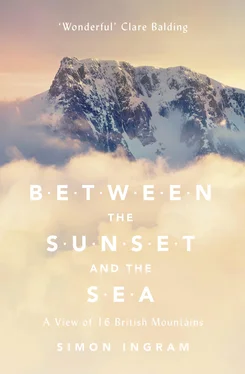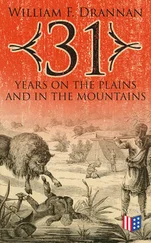The act of climbing a mountain – any mountain, anywhere – is to enter an environment that is challenging simply to be in. Up there, a vertical kilometre above you in that high ground, life is dangerously simple. Things wilt down to the basics: get up, move, keep warm, stay alive, get back. Trivialities at sea level, such as shelter and water, become coveted luxuries. All of a sudden we’re back in the state of primal essentiality that as a species humankind has been developing away from for thousands of years. It’s not like walking through the woods, or a trip to the park. Here you’re beyond the darkness at the edge of town. You’re walking back in time. It’s like anthropological nostalgia.
The things you see here in the high places become a visual drug. Once seen and felt, you’ll drive hundreds of miles just to be in this hard ancient landscape, and recapture those emotions. Spend sizeable amounts of money. Make personal sacrifices. Struggle through all weathers and dangers. And you probably won’t be able to explain why.
Some have tried, of course. There are many ‘justifications’ for climbing a mountain, some of them notoriously impenetrable, some of them shamelessly contradictory. You climb it because it’s there. You go up, to come down. None of them make much sense. Because in the pursuit of the profound, many of them compromise simple honesty: being on a mountain, a witness to its ways, just feels incredible. To hear the silence of a high stream frozen tight; to feel an ice-laden wind sizzle your skin; to stand on the prow of a mountaintop and look down on an ocean of lilac-lit clouds, whilst civilisation below slumbers beneath their shroud – and to live in a country where you can do all of this in the slender gap between Friday night and Monday morning. For anyone with even a vague appreciation of nature, climbing a mountain is a rare blessing: the closest you can get to a full-on sensory epiphany.
But mountains – particularly ours – are so much more than simply things to climb. Mountains aren’t things at all; things are just there . Mountains are places . And places are worth getting to know. Visiting. Inhabiting. Investigating. In places, things happen.
But first, something’s got to find that part of you, if it’s there. Find it, check its pulse, then really wake it up.
It was late October, and a filthy sky hung above the mountains of Glen Coe as I followed the road snaking its way between them, then continued north. Where I live in England’s east the horizon is empty of mountains; it is in fact a place particularly notable for its flatness. But this morning the skies above Lincolnshire had been full of the hard contrasts of dawn, and a solid grey weather front approaching the county from the west gave the convincing and novel impression that there was a tall, plateau-topped mountain range where there was in fact none. I allowed myself to imagine for a few minutes this wasn’t an illusion, and immediately the landscape’s entire mood shifted. Where before there had been just boundless sky, suddenly here was a presence in the landscape far more noticeable than anything else. Something to look at and, indeed, something looking back. This is the slightest dab of the feeling that fortifies the mood of the places overlooked by mountains for real. Of these, the valley of Glen Coe is perhaps the most overlooked of all – although my destination on this particular afternoon must surely run a close second.
I was driving through Scotland to Torridon, a nest of mountains in the remote North-west Highlands, to climb a peak by the name of Beinn Dearg. The summit of this otherwise anonymous hill isn’t on a lot of people’s lists of lifetime ambitions. Most people – even seasoned hillwalkers – will never climb it, particularly considering the visually throatier mountains nearby. And yet here I was, returning to climb it a second time, because ten years ago it had been Beinn Dearg that had checked my own mountain pulse.
That day the weather had been flawless. The September air was velvet warm, and blue sky and sun left the sharp mountains of Torridon entirely innocent of the malignant cloud or sudden wind so notorious in the Highlands. My companion Tom and I had sat in the breakfast area of the Torridon Inn that morning over a map of closely bunched contours when a man we correctly identified as both a local and a walker – in that he had a strong Scottish accent, shocked hair and wore a pink jacket that looked like it might once have been red – enquired as to our day’s objective.
‘Fine wee hill,’ he’d said when I pointed it out on the map.
I’d been preoccupied with the contour lines on the mountain’s western flank since the previous evening. Contours that were close together meant a steep slope; these ones were touching each other.
‘Is it difficult? It looks steep.’
‘Steep, aye. Hands-in-pockets job once you’re up, though.’
‘Hands in pockets?’
‘Aye, a bimble. Have a good day, lads.’
He winked and, with the beanpole stoop of an ageing hillwalker, was gone.
‘What does he mean?’ I hissed across the table at Tom as the door clapped shut behind him and my eyes again fell upon the closely bunched orange lines covering the map. ‘Hands in pockets? Bimble?’
Tom – who I should say was rather more experienced in such matters – was busy scrutinising the map for a parking place.
‘He means if the first bit doesn’t kill us we’ll be fine.’
Vernacular is likely to be one of your first obstacles to overcome before you feel at home in a conversation with those who climb mountains for fun. Like most niche pursuits, you’ll find yourself absorbing it as you go via a kind of linguistic osmosis. You bag summits, you don’t climb them. Tricky parts of a mountain route don’t yield: they go . You’re not off to have a walk, you’re going on the hill . Feel scared on the hill and you’re probably doing something a bit necky . The thing that’s scaring you is probably exposure . In plain English you might be reaching the summit but to a mountaineer you’re topping out . A walk is a bimble , a hard walk a yomp , something that needs hands and a strong stomach is a scramble . If it’s blowing a hoolie you don’t really want to be up there. And all of this isn’t really a walk; it’s a route . Gear is kit , sustenance hill food , anoraks shells and – just in case you get conversationally caught out – underpants are shreddies , though it’s probably best not to ask why. In addition, a certain amount of understatement is required if you want to capture the severity of the task in hand in a suitably humble manner: hence frequent use of, for example, ‘a bit rough’, ‘a lively wind’ and ‘a couple of interesting bits’ to describe something that most people would describe as twelve hours spent on a terrifying cliff in a hurricane. There’s more, but don’t worry. You’ll pick it up.
Of the ascent that took place that day in 2004, I remember three things as if tattooed with them. The first was the endless view, which carried our eyes not only over the scenically incandescent peaks of Torridon – I didn’t know their names at that point – and beyond to the Isle of Skye, where cartoonishly sharp, island-isolated peaks straddled the horizon like an open bear-trap. The second was the golden eagle we saw hunched against a crag near the mountain’s summit not twenty metres from where we were walking: a sight that stopped and silenced Tom and me in unison. We just stared at it, watching it blink, seeing the edges of its feathers quiver in the wind. Then, this beautiful, Labrador-sized thing unfurled its wings – a metre each – and nonchalantly plunged from its crag into the drop beneath it. If it moved because of our presence, it certainly didn’t make it obvious.
Читать дальше












